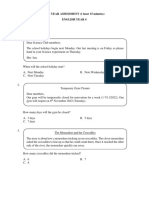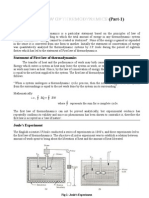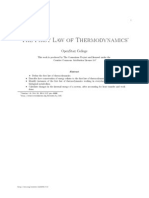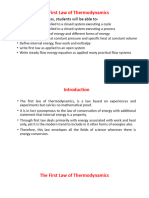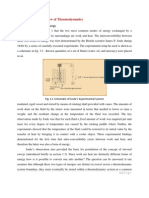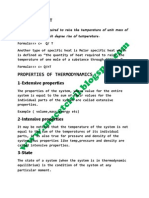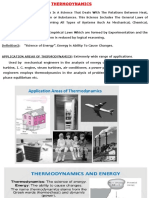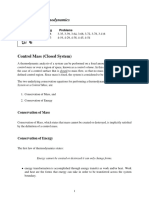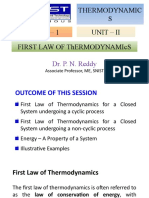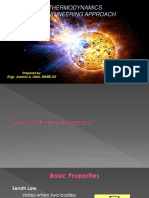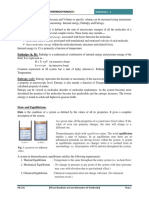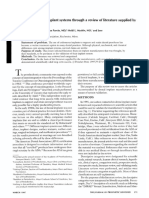Lec 04
Lec 04
Uploaded by
MesipCopyright:
Available Formats
Lec 04
Lec 04
Uploaded by
MesipOriginal Title
Copyright
Available Formats
Share this document
Did you find this document useful?
Is this content inappropriate?
Copyright:
Available Formats
Lec 04
Lec 04
Uploaded by
MesipCopyright:
Available Formats
[BASIC THERMODYNAMICS] First Law of Thermodynamics (Non-flow Process)
The first law of thermodynamics is often called as the law of the conservation of energy, with
particular reference to heat energy and mechanical energy i.e. work.
First law of thermodynamics for a closed system undergoing a cyclic process
The transfer of heat and the performance of work may both cause the same effect in a system.
Energy which enters a system as heat may leave the system as work, or energy which enters the
system as work may leave as heat. Hence, by the law of conservation of energy, the net work
done by the system is equal to the net heat supplied to the system. The first law of
thermodynamics can therefore be stated as follows:
“When a system undergoes a cyclic change, the net heat to or from the system is equal to the net
work from or to the system.”
J Q W where represents sum for a complete cycle.
The first law of thermodynamics cannot be proved analytically, but experimental evidence has
repeatedly confirms its validity and since no phenomenon has been shown to contradict it,
therefore the first law is accepted as a ‘law of nature’.
Joule’s Experiment:
Figure: Joule’s Experiment Figure: Cycle completed by a system
with two energy interactions i.e.,
work transfer followed by heat
transfer
ME 2101 [These Handouts are not alternative of Textbooks] Page 1
[BASIC THERMODYNAMICS] First Law of Thermodynamics (Non-flow Process)
Figure shows the experiment for checking the first law of thermodynamics. The work input to
the paddle wheel is measured by the fall of weight, while the corresponding temperature rise of
liquid in the insulated container is measured by the thermometer.
The process 1-2 undergone by the system is shown in figure i.e., W1-2. Let the insulation be
removed. The system and the surrounding interact by heat transfer till the system returns to its
original temperature, attaining the condition of thermal equilibrium with the atmosphere. The
amount of heat transfer Q2-1 from the system during this process 2-1 is shown in figure. The
system thus executes a cycle, which consists of a definite amount of work input W1-2 to the
system followed by the transfer of an amount of heat Q2-1 from the system.
Joule carried out many such experiments with different type of work interactions in a variety of
systems, he found that the network input the fluid system was always proportional to the net
heat transferred from the system regardless of work interaction. Based on this experimental
evidence Joule stated that,
“When a system (closed system) is undergoing a cyclic process, the net heat transfer to the
system is directly proportional to the net work done by the system”. This statement is referred to
as the first law for a closed system undergoing a cyclic process.
i.e., Q W
If both heat transfer and work transfer are expressed in same units as in the S.I. units then the
constant of proportionality in the above equation will be unity and hence the mathematical form
of first law for a system undergoing a cyclic process can be written as
i . e , Q W
If the cycle involves many more heat and work quantities as shown in figure, the same result will
be found.
Figure: Cyclic Process on a Property Diagram
For this cyclic process the statement of first law can be written as
Q W
12341 12341
The cyclic integral in the above equation can be split into a series of non-cyclic integral as
ME 2101 [These Handouts are not alternative of Textbooks] Page 2
[BASIC THERMODYNAMICS] First Law of Thermodynamics (Non-flow Process)
or 1Q2 + 2Q3 + 3Q4 + 4Q1 = 1W2 + 2W3 + 3W4 + 4W1
i.e., Q = W
or (∑Q)cycle = (∑W)cycle
This is the first law for a closed system undergoing a cyclic process. i.e., it is stated as
“When a closed system is undergoing a cyclic process the algebraic sum of heat transfers is equal to the
algebraic sum of the work transfers”.
First law for a closed system undergoing a non-cyclic process (i.e., for a change of state):
If a system undergoes a change of state during which both heat transfer and work transfer are
involved, the net energy transfer will be stored or accumulated within the system.
Consider a system that undergoes a cycle, changing from state 1 to state 2 by process A or by process
C and returning from state 2 to state 1 by process B.
So two distinct cyclic processes here, 1-A-2-B-1 and 1-C-2-B-1.
For Cycle 1-A-2-B-1
For Cycle 1-C-2-B-1
The physical significance of the property E is that it represents all the energy of a system at a given
state.
If Q is the amount of heat transferred to the system and W is the amount of work transferred
from the system during the process as shown in figure,
W The net energy transfer (Q-W) will be stored in the
system as energy.
System Q-W = ∆E, Where ∆E is the net increase in the
Q energy of the system.
ME 2101 [These Handouts are not alternative of Textbooks] Page 3
[BASIC THERMODYNAMICS] First Law of Thermodynamics (Non-flow Process)
Energy of the System:
Internal energy is associated with internal structure of matter. This energy cannot be determined in its
absolute values. But it is possible to determine the change in internal energy of the system undergoing a
process by first law of thermodynamics.
Total energy E = KE + PE + IE
Since the terms comprising E are point functions, we can write
dE = d(KE) + d (PE) + dU
The first law of thermodynamics for a change of state of a system may therefore be written as
Q = dU + d (KE) + d (PE) + W
In words this equation states that as a system undergoes a change of state, energy may cross the
boundary as either heat or work, and each may be positive or negative. The net change in the energy of
the system will be exactly equal to the net energy that crosses the boundary of the system. The energy of
the system may change in any of three ways, namely, by a change in IE, KE or P.E.
Sub. For KE and PE in the above equation
2
d (mV )
Q = dU + + d (mgZ) + W
2
ME 2101 [These Handouts are not alternative of Textbooks] Page 4
[BASIC THERMODYNAMICS] First Law of Thermodynamics (Non-flow Process)
In the integral form this equation is, assuming ‘g’ is a constant.
Most closed systems remain stationary during a process and thus experience no change in their kinetic
and potential energies. Closed systems whose velocity and elevation of the center of gravity remain
constant during a process are frequently referred to as stationary systems.
In this text, a closed system is assumed to be stationary unless stated otherwise.
Hence, Q dU W
Or in integral form, Q1-2 = U2 – U1 + W1-2 . This equation is known as Non-flow
Energy Equation.
ME 2101 [These Handouts are not alternative of Textbooks] Page 5
[BASIC THERMODYNAMICS] First Law of Thermodynamics (Non-flow Process)
Law of conservation of energy (2nd corollary of first law of thermodynamics)
From first law of thermodynamics Q1-2 = E2 – E1 + W1-2
This equation in effect is a statement of the conservation of energy. The net change of the energy of the
system is always equal to the net transfer of energy across the system boundary as heat and work.
For an isolated system, Q = 0, W = 0. Hence, E2 – E1 = 0
For an isolated system, the energy of the system remains constant.
Therefore, the first law of thermodynamics may also be stated as follows, “The internal Energy of a
closed system remains unchanged if the system is isolated from its surrounding”.
Perpetual Motion Machine of first kind (PMM-I) (3rd Corollary):
Any system which violates the first law of thermodynamics is called the Perpetual Motion machine of
first kind. i.e., “It is impossible to construct a perpetual motion machine of first kind”. A perpetual
machine is one which can do continuous work without receiving energy from other systems or
surroundings. It will create energy on its own and thus violates first law. But from our experience we
also know that it is impossible to construct such a machine, as frictional resistance would not allow it to
run for an indefinite period.
Motor Generator
REFERENCE: ANJAN GOSWAMI
Assistant Professor,
Dept. of MPE, AUST
ME 2101 [These Handouts are not alternative of Textbooks] Page 6
You might also like
- Shrek The Musical ScriptDocument44 pagesShrek The Musical ScriptDayna WilsonNo ratings yet
- 2022 Suggested UASA Year 4Document6 pages2022 Suggested UASA Year 4LILY67% (3)
- First Law of Thermodynamics For A Control MassDocument51 pagesFirst Law of Thermodynamics For A Control MassTushyNo ratings yet
- Chapter 4 ThermoDocument30 pagesChapter 4 ThermoXin Ying100% (1)
- First Law of Thermodynamics Theory 1Document33 pagesFirst Law of Thermodynamics Theory 1manilrajkrr6302100% (1)
- The First Law of Thermodynamics: Openstax CollegeDocument11 pagesThe First Law of Thermodynamics: Openstax CollegeVirginia FernandezNo ratings yet
- ME 2801 2 First Law of ThermodynamicsDocument79 pagesME 2801 2 First Law of ThermodynamicsRamjan Ali SiamNo ratings yet
- New Microsoft PowerPoint PresentationDocument18 pagesNew Microsoft PowerPoint PresentationLokesh BaviskarNo ratings yet
- Thermal FluidDocument19 pagesThermal FluidOsama F. AnabtawiNo ratings yet
- Energy and The First Law of ThermodynamicsDocument60 pagesEnergy and The First Law of ThermodynamicsNguyễn Anh TàiNo ratings yet
- First Law of Thermodynamics: Cycle CycleDocument32 pagesFirst Law of Thermodynamics: Cycle CycleT Hari PrasadNo ratings yet
- Engineering Mechanics: Second PartDocument18 pagesEngineering Mechanics: Second Partاحمد سلمان عزيز , مسائيCNo ratings yet
- First Law of ThermodynamicsDocument2 pagesFirst Law of ThermodynamicsbabeNo ratings yet
- CCTD101B Notes 4 - 1st Law of ThermodynamicsDocument7 pagesCCTD101B Notes 4 - 1st Law of ThermodynamicsShan ShanzNo ratings yet
- Thermo Module 4Document35 pagesThermo Module 4Royce SumagaysayNo ratings yet
- The First Law of Thermodynamics-2Document64 pagesThe First Law of Thermodynamics-2Sayan MondalNo ratings yet
- E233 - Thermofluids: The First Law of ThermodynamicsDocument12 pagesE233 - Thermofluids: The First Law of ThermodynamicsYingyote LubphooNo ratings yet
- Chemical Engineering ThermodynamicsDocument11 pagesChemical Engineering ThermodynamicsP P DNo ratings yet
- Chapter 3 - First Law of ThermodynamicsDocument24 pagesChapter 3 - First Law of ThermodynamicsMUHAMMED FAISALNo ratings yet
- 03 Part1a To CMSDocument32 pages03 Part1a To CMSthahirhussainNo ratings yet
- L2 (Energy Analysis)Document31 pagesL2 (Energy Analysis)Kavin KabilanNo ratings yet
- Lecture 3 ThermodynamicsDocument54 pagesLecture 3 Thermodynamicstorawe6575No ratings yet
- Week 7 2014Document21 pagesWeek 7 2014Nicole Anne BorromeoNo ratings yet
- Chapter - 2 For e ClassDocument25 pagesChapter - 2 For e Classparsa.shakeri.bavilNo ratings yet
- CHAPTER 3: First Law of Thermodynamics: 3.1 Concept of Internal EnergyDocument18 pagesCHAPTER 3: First Law of Thermodynamics: 3.1 Concept of Internal EnergyMangesh UgrankarNo ratings yet
- Assignment of PhysicsDocument3 pagesAssignment of Physicsaimannaveed402No ratings yet
- ThermodynamicsDocument18 pagesThermodynamicseka123No ratings yet
- Applied Thermodynamic NotesDocument83 pagesApplied Thermodynamic NotesMukesh KumarNo ratings yet
- Chapter Three First Law of Thermodynamics: Fig. 3-1 Cyclic ProcessDocument9 pagesChapter Three First Law of Thermodynamics: Fig. 3-1 Cyclic ProcessEnenamahNo ratings yet
- Aero 3sem 111302nolDocument103 pagesAero 3sem 111302nolvaishu1991No ratings yet
- Q & A - Basic ThermoDocument32 pagesQ & A - Basic ThermoManoranjan Kumar SinghNo ratings yet
- The First Law of ThermodynamicsDocument2 pagesThe First Law of ThermodynamicsRudreshNo ratings yet
- Applications of The First Law of ThermodynamicsDocument17 pagesApplications of The First Law of ThermodynamicsScribdTranslationsNo ratings yet
- ME1100 01 Fundamentals PDFDocument7 pagesME1100 01 Fundamentals PDFYokesh P S ae22b065No ratings yet
- 1st Law of ThermodynamicsDocument20 pages1st Law of ThermodynamicsellayuslianaNo ratings yet
- Thermo Chap IIIDocument22 pagesThermo Chap IIIAnb BajwaNo ratings yet
- Chapter 02 Energy, Energy Transfer, and General Energy AnalysisDocument42 pagesChapter 02 Energy, Energy Transfer, and General Energy Analysislassi19aNo ratings yet
- Basic Electro MECHANICAL Engineering NotesDocument9 pagesBasic Electro MECHANICAL Engineering NotesMohsin Gondal100% (1)
- FALLSEM2020-21 MEE1003 TH VL2020210103023 Reference Material I 29-Jul-2020 First Law of Thermodynamics - IDocument17 pagesFALLSEM2020-21 MEE1003 TH VL2020210103023 Reference Material I 29-Jul-2020 First Law of Thermodynamics - IRahul rajelliNo ratings yet
- THERMODocument24 pagesTHERMOSatish HulmaniNo ratings yet
- Lecture6a FirstLawofThermodynamicsDocument4 pagesLecture6a FirstLawofThermodynamicsMuhammadHamzaNo ratings yet
- Thermodynamics 3 - Chapter 3Document32 pagesThermodynamics 3 - Chapter 3steyvohmannaNo ratings yet
- Lab Cover C2Document34 pagesLab Cover C2MD. ATIQUL HAQUE TANIMNo ratings yet
- CPC2 Lecture 2Document5 pagesCPC2 Lecture 2Adu GilbertNo ratings yet
- Chapter 8Document37 pagesChapter 8yobingewatcher06No ratings yet
- Heat and Work. Systems (Or A System and Its Surroundings) by Virtue of A Temperature DifferenceDocument7 pagesHeat and Work. Systems (Or A System and Its Surroundings) by Virtue of A Temperature DifferenceGetachew TikueNo ratings yet
- Module 2Document28 pagesModule 2Nk KumarNo ratings yet
- Chapter 4 Energy and Energy BalanceDocument29 pagesChapter 4 Energy and Energy BalanceNamie SamadNo ratings yet
- Chapter 3Document45 pagesChapter 3aberamamo15No ratings yet
- 2-1 First Law of Thermodynamics - Session 1Document38 pages2-1 First Law of Thermodynamics - Session 1Baddam Jayasurya ReddyNo ratings yet
- 340 Sample ChapterDocument49 pages340 Sample ChapterRajbir SinghNo ratings yet
- HK I TermodinamikaDocument21 pagesHK I TermodinamikaPutri Desty AmeliaNo ratings yet
- The First Law and Other Basic Concepts: Adnan Akhtar Adnan - Akhtar@sharif - Edu.pkDocument34 pagesThe First Law and Other Basic Concepts: Adnan Akhtar Adnan - Akhtar@sharif - Edu.pkAdnan AKhtarNo ratings yet
- 002general Energy Analysis of THERMODYNAMICSDocument30 pages002general Energy Analysis of THERMODYNAMICSm7sen mohammedNo ratings yet
- Chapter 1. The First Law of Thermodynamics For Close System Key Learning OutcomesDocument16 pagesChapter 1. The First Law of Thermodynamics For Close System Key Learning OutcomesLi BushNo ratings yet
- ThemoDynamics For IitjeeDocument41 pagesThemoDynamics For Iitjeevarundhall19940% (1)
- First Law of ThermodynamicsDocument50 pagesFirst Law of ThermodynamicsRohit Singh LatherNo ratings yet
- Thermodynamics An Engineering Approach: Prepared By: Engr. Joselito A. Olalo, MSME-EEDocument19 pagesThermodynamics An Engineering Approach: Prepared By: Engr. Joselito A. Olalo, MSME-EEAljohn Mark ReyesNo ratings yet
- Chapter 9 Laws of ThermodynamicsDocument16 pagesChapter 9 Laws of Thermodynamicsjunroel15No ratings yet
- Thermodynamics 1 - Energy, Energy Transfer, and General Energy AnalysisDocument21 pagesThermodynamics 1 - Energy, Energy Transfer, and General Energy AnalysisFlorasaurus17100% (1)
- “Foundations to Flight: Mastering Physics from Curiosity to Confidence: Cipher 4”: “Foundations to Flight: Mastering Physics from Curiosity to Confidence, #4From Everand“Foundations to Flight: Mastering Physics from Curiosity to Confidence: Cipher 4”: “Foundations to Flight: Mastering Physics from Curiosity to Confidence, #4Rating: 5 out of 5 stars5/5 (1)
- Automobile L 7Document47 pagesAutomobile L 7MesipNo ratings yet
- Automobile L 2Document14 pagesAutomobile L 2MesipNo ratings yet
- Automobile L 6Document38 pagesAutomobile L 6MesipNo ratings yet
- Automobile L 4Document25 pagesAutomobile L 4MesipNo ratings yet
- Automobile L 8Document51 pagesAutomobile L 8MesipNo ratings yet
- Automobile L 5Document72 pagesAutomobile L 5MesipNo ratings yet
- LEC - 5 - ME - 4203 (Actual L-6)Document67 pagesLEC - 5 - ME - 4203 (Actual L-6)MesipNo ratings yet
- ThermodynamicsDocument147 pagesThermodynamicsMesipNo ratings yet
- Automobile L 3Document13 pagesAutomobile L 3MesipNo ratings yet
- Lec 03Document11 pagesLec 03MesipNo ratings yet
- Lec 02Document6 pagesLec 02MesipNo ratings yet
- Lec 01Document4 pagesLec 01MesipNo ratings yet
- SpeechDocument2 pagesSpeecheiyrulNo ratings yet
- ENEA TurbogasDocument124 pagesENEA TurbogasSimone CastagnoNo ratings yet
- Living Organisms and Their EnvironmentDocument16 pagesLiving Organisms and Their EnvironmentSamuelNo ratings yet
- Entrepreneurship For Engineers Ins. Aschalew Mengistu (MBA)Document130 pagesEntrepreneurship For Engineers Ins. Aschalew Mengistu (MBA)FraolNo ratings yet
- Rust Prevention PDFDocument6 pagesRust Prevention PDFAliakbar GhaderiNo ratings yet
- KCLAS Club's Registration Form'21 (1-547)Document17 pagesKCLAS Club's Registration Form'21 (1-547)GANESAPANDI NAGARATHINAMNo ratings yet
- 01 Essay 1 NSTPDocument1 page01 Essay 1 NSTPJanine CundanganNo ratings yet
- Dear CandidateDocument3 pagesDear CandidateIkram ShahzadNo ratings yet
- Validation of Dental Implant Systems Through A Review of Literature Supplied by System ManufacturersDocument9 pagesValidation of Dental Implant Systems Through A Review of Literature Supplied by System ManufacturersDr FarhatNo ratings yet
- Ebook Hafele Furniture Fittings CompactDocument32 pagesEbook Hafele Furniture Fittings CompactIkhsanul HakimNo ratings yet
- Insider Cures August2013Document8 pagesInsider Cures August2013WalterNo ratings yet
- Technical Aptitude QuestionsDocument151 pagesTechnical Aptitude QuestionsGodwin SvceNo ratings yet
- Kipling, The Whites Man BurdenDocument3 pagesKipling, The Whites Man BurdenRamon VenegasNo ratings yet
- Week 8 PowerPoint Slide NotesWeek 8 Tim 8530Document15 pagesWeek 8 PowerPoint Slide NotesWeek 8 Tim 8530m8thmilitantNo ratings yet
- Sunfeast FinalDocument30 pagesSunfeast FinalSowmya Katkuri0% (1)
- Religions and Belief SystemsDocument23 pagesReligions and Belief SystemsSunshine GarsonNo ratings yet
- Ayush Resume PDFDocument2 pagesAyush Resume PDFHarsh Kumar SahuNo ratings yet
- Barrett Beyond Psychometrics 2003 AugmentedDocument34 pagesBarrett Beyond Psychometrics 2003 AugmentedRoy Umaña CarrilloNo ratings yet
- BU6009 Assignment 1Document2 pagesBU6009 Assignment 1Sana MohdNo ratings yet
- Chromatic Mediant RelationshipsDocument1 pageChromatic Mediant Relationshipsrogeriomenegaz100% (2)
- Information Processing TheoryDocument2 pagesInformation Processing TheoryJos Van ElzNo ratings yet
- Đề Kiểm Tra 1 Tiết Môn Tiếng Anh 10Document6 pagesĐề Kiểm Tra 1 Tiết Môn Tiếng Anh 10Son Ca Nguyen ThiNo ratings yet
- Unit 28 - Prototyping-Reworded-2021Document14 pagesUnit 28 - Prototyping-Reworded-2021Jimmy CyrusNo ratings yet
- UoS BABS L4 T1 MM Assignment October - December 2020Document13 pagesUoS BABS L4 T1 MM Assignment October - December 2020Robert ChiroboceaNo ratings yet
- SDCAAsia PacificMultidisciplinaryResearchJournalDocument69 pagesSDCAAsia PacificMultidisciplinaryResearchJournalTerem TebaNo ratings yet
- CSC315 System Analysis and DesingDocument4 pagesCSC315 System Analysis and DesingMag CreationNo ratings yet
- The Dutch Oven 2Q13Document25 pagesThe Dutch Oven 2Q13lsdostrusteeNo ratings yet
- Inner Circle Trader - TPDS 2Document3 pagesInner Circle Trader - TPDS 2Sonja Moran83% (6)

